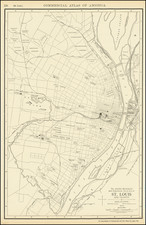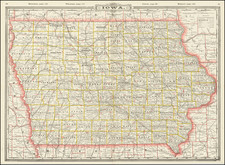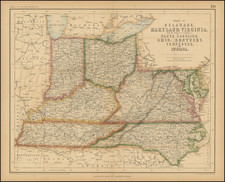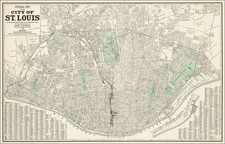"One of the most important contributions ever made to American geography''-- Bray, Joseph Nicollet and his Map, page xv.
This is the original mammoth six-sheet Nicollet & Fremont map of the hydrographical basin of the Upper Mississippi River, the foundational modern mapping of Upper Midwest and Great Plains. This is the first map to locate the true source of the Mississippi, and it is the first mapping of the region based on instrument and astronomical observations.
The map claims a series of glowing endorsements from modern scholars. Schartz and Ehrenberg comment that "Nicollet's map initiated the scientific mapping of the trans-Mississippi West by the War Department." Rumsey remarks that "the map was years ahead of its time, with its regional concept and sound basis in instrument readings and astronomically determined points."
The map is the first to chart the Mississippi River utilizing mathematical calculations to confirm the true source of the Mississippi. In total, Nicollet utilized over 90,000 readings.
Nicollet's map is the earliest accurate mapping of the interior of North America, from St. Louis north to the Canadian Border, and west along the Missouri River.
Joseph Nicholas Nicollet
Nicollet (1786-1843), was a French scientist, geographer, and mathematician. Before emigrating to America, he was a professor of mathematics at College Louis-Le-Grand. Nicollet was also a gifted astronomer, having worked at the Paris Observatory, as well as the College. The July Revolution of 1830 compounded professional difficulties he was experiencing and led him to seek a name for himself in America, sailing from Brest in 1832.
In America, he led three important expeditions between the Mississippi and Missouri Rivers, from 1836 through 1839, largely in present-day Minnesota, South Dakota, and North Dakota. His Map of the Hydrographical Basin of the Upper Mississippi covers parts of what would become eight states.
First expedition, 1836–37
Nicollet's first expedition was privately funded by the American Fur Company and the Chouteau family of St. Louis. Starting at Fort Snelling on July 29, 1836, Nicollet ascended the Mississippi River by canoe to its headwaters at Lake Itasca. He also explored the St. Croix River, which now forms much of the border between Minnesota and Wisconsin. Through his explorations, he was able to correct an error in Zebulon Pike's 1805 map of the Mississippi, which placed the map of the Crow Wing River too far to the west.
Second expedition, 1838
Nicollet went to Washington, D.C. with the results of his expedition, and having impressed government officials with his abilities, was placed in chart of the newly-formed Corps of Topographical Engineers. The Crow Wing River error on Pike's map was a major cartographic issue, as his map had influenced all mappings of the area between the Mississippi and Missouri that followed. To correct this, a War Department-funded expedition set out under Nicollet's command, departing Travers des Sioux on June 18, 1838.
On the second expedition, he was accompanied by none other than John C. Fremont, who participated in lieu of a military escort. An agent of the American Fur Company also joined them. The party headed to southwestern Minnesota and then into northern Iowa to chart the area in between the Missouri and the Mississippi Rivers.
Third expedition
A third expedition saw Nicollet and Fremont travel northwest from Iowa along the Missouri River toward Fort Pierre, South Dakota.
Nicollet returned to Washington on September 11, 1839. There he worked on compiling the information he had gathered on his expeditions. The result was the present map, which dramatically improved the cartography of the upper plains, and was published by order of the U.S. Senate in 1842. In 1843, a book and reduced-size version of the map (with topography added), was issued as well.
Nicollet died in 1843 before he could return to continue his work in Minnesota and on the Plains as he had planned.
Rarity
The map has traded only once in recent history, at Swann Galleries in 2006, where it sold for $59,800.
OCLC records nine examples: NYPL, UCLA, Yale, Harvard, Mass Historical, Dartmouth, UW Milwaukee, Abraham Lincoln Presidential Library, and Fargo Public Library. Many of these institutions likely received the publication as original government depositories.













![Diagram showing ceded and reserved Chippewa lands in Minnesota [with:] In the Supreme Court of the United States. October Term, 1912.](https://storage.googleapis.com/raremaps/img/small/93674.jpg)
